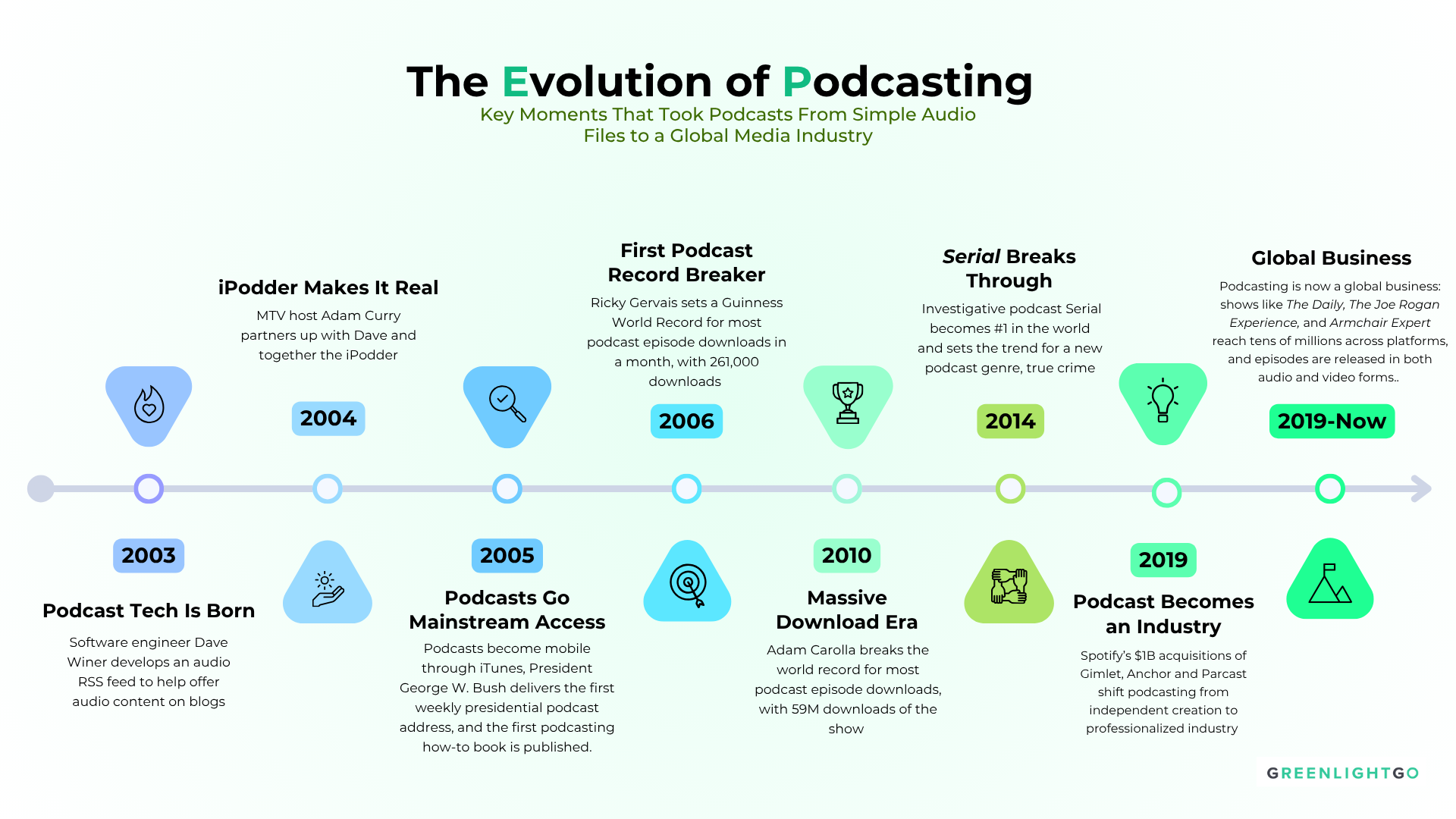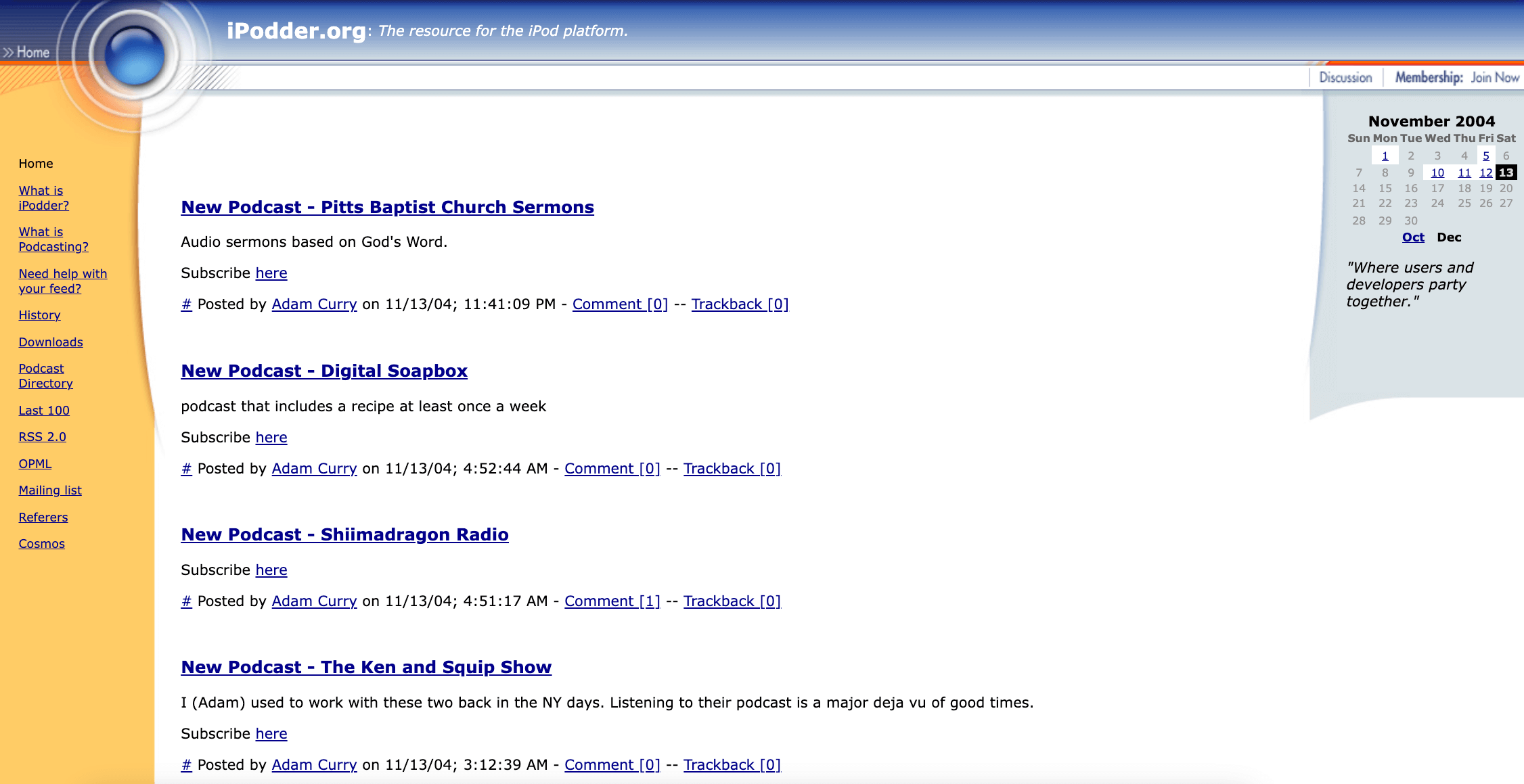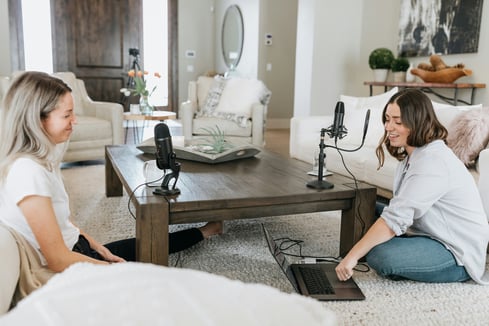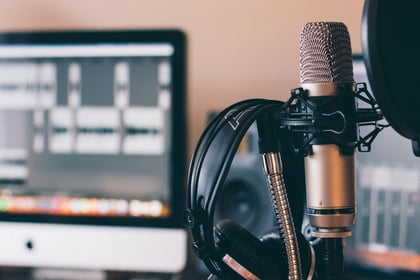AI’s advent in the entertainment industry was not if or when, but how.
The History of the Podcast
Developing media of any kind has been through monumental changes in the past 20 years, as every channel as we knew it evolved into a more modern alternative. There were newspapers before blogs. There was MTV before Spotify and Apple Music. There was even Blockbuster before Netflix. But what about the podcast? With over 100 million listeners weekly, and 14% of those being daily listeners, this source of entertainment (and knowledge!) has also seen major changes since its debut on the market.

This blog will take a closer look at the origins of the podcast, its development through the years, and the forecasted trends and developments of the podcast at a global level. Let’s get into it!
Table of Contents
2. Technological Developments for the iPodder
3. The Rising Trend of the Podcast
4. Podcast Production Becomes Business
5. What Makes Podcasts Popular in 2025
6. Global Podcast Market - Trends & Developments
7. Finding the Best Podcast Studio
Origins of the Podcast
It’s 2003. You’re in a coffee shop, and notice just how many people are carrying the latest iPod.
You hear mentions of a “magic radio” going around. One you could download on your iPod and listen to whenever you wanted. They’re even saying anyone can create and post it online. There’s no way. You don’t believe it. You resume your music download.
Except, it’s true.
Software engineer Dave Winer develops an audio RSS feed to help former New York Times journalist and public radio host Christopher Lydon offer audio content of his notable interviews available on his blog.
One year later, just after the audio RSS feed picks up, MTV host Adam Curry partners up with Dave, and together they create The iPodder, an automatic way of downloading audio files to iPods. You are fascinated, intrigued, eager to see it with your own eyes. It’s not a magic radio, but the start of on-demand audio sharing. On the iPod. But it’s broadcast. It’s a podcast. The podcast is now gaining momentum. Its capabilities go beyond the iPod. You look into it, and find Liberated Syndication, or Libsyn: the first podcast hosting platform.
Technological Developments for the iPodder
Now it’s 2005 and the podcast is gaining more and more popularity. Apple is improving its iPhone with every launch, and the iOS has even more features than last year. One of the most awaited features is iTunes’s native support of podcasts, directly via iTunes. It’s even easier now to discover and download podcasts.

Thinking back on it, you can’t believe you almost missed out on podcasting. Even the president, George W. Bush is an early adopter. He becomes the first president to deliver a weekly address as a podcast. This gives you the confidence that maybe, you’re going to start a podcast too, become a trendsetter and retire at 40. If only. But you don’t know anything about it. A textbook might be helpful. Well, you’re just in luck, because Podcasting: Do-It-Yourself Guide by Todd Cochrane just got published. Maybe you could still do it after all.
Podcasting is reaching a broader audience by the day and early adopters are now daily users. Celebrities and popular talk show hosts are among them. Your favorite? Ricky Gervais, who in 2006, sets a Guinness World Record for most downloads in one month, specifically 261,670 downloads per episode. Even radio shows like This American Life begin offering podcasts then. It’s inspiring. You feel connected to history. Not because you witness it, but because you take part in it.
The Rising Trend of the Podcast
We fast forward and suddenly, it’s the 2010s. Smartphones are mainstream now and fast internet is a given. Podcasts are not a novelty anymore, but they still manage to spark interest. There’s so many topics to listen to and the possibilities seem endless.
Remember the Guinness World Record for most downloads in a month?
Yeah, that’s old news. Adam Carolla just broke the record, with over 59 million downloads of his show, The Adam Carolla Show. Also, you’re kind of over all the radio shows and the existing content. Is it over? The thrill of the podcast is dying down already? False. It’s still just the beginning.
The podcast gets to a turning point, when in October 2014, the investigative, true crime podcast Serial launches, being the first of its kind. It’s also the first one to go mainstream and gain more than 500 million downloads on iTunes, gaining around 1.5 million downloads per episode. This niche will become one of the most popular categories, being the third most listened to category in podcast listeners worldwide. Thrilling for sure.
-1.jpg?width=935&height=569&name=Memories%20Photo%20Collage%20(1)-1.jpg)
After Serial’s success in 2014, major figures from media and entertainment launched their own podcasts, bringing their existing audiences into this new medium. Some notable examples are The New York Times’ Michael Barbaro who hosts The Daily, reaching 3 million daily listeners, actor and comedian Dax Shepard, and his podcast Armchair Expert, who has an audience of more around 20 million people, making it one of the top-earning podcast in the U.S., and Joe Rogan, with The Joe Rogan Experience, who has a massive listenership, specifically 51 million people across Spotify and YouTube.
The podcast as you knew it 10 years ago is so much more than a hobby or extension of the radio. It’s a whole business in itself.
Podcast Production Becomes Business
In 2019, Spotify’s 1 Billion Dollars acquisitions of Gimlet, Anchor, and Parcast, former independent podcasting companies, successfully made podcasting’s shift from independent creation to a professionalized industry. There are new monetization strategies that emerge, such as ads, affiliate marketing, sponsorships, raising production quality and incentivizing more creators.
What Makes Podcasts Popular in 2025
Listeners love podcasts because they’re on-demand and personalized. You can learn, laugh, or just listen to interesting conversations while driving, cooking, studying or exercising. Most popular podcast streaming platforms, like Spotify and Apple Podcasts, offer recommendations based on your interests and search history, creating special lists using algorithms for listeners.
One of the most important factors driving popularity is smartphones. Audiences have the freedom to listen anytime, anywhere, while creators have a global market to expand their stories and thoughts. The best example of this feature was seen during the 2020 pandemic, when it seemed like there was a new podcast everyday. Because there were!

When COVID-19 lockdowns began, global podcast downloads initially dropped by about 20%, since people were not commuting anymore and listening to podcasts in their cars or on the way to school. But the trend quickly reversed as creators adapted to remote production. This changed the podcast landscape completely, as by the end of 2020, more than 1 million new podcasts had launched: three times the number from 2019.
This shift established a new wave of independent and professional creators worldwide. If you had a microphone, an idea and possessed enough charisma, the world was your oyster.
Global Podcast Market - Trends & Developments
Podcasting has become a truly global medium, with over 584 million listeners worldwide as of 2025.
While the U.S. and Canada have the highest number of podcast listeners, there is significant growth in Asia-Pacific and Latin America, where the increased access to smartphones and the multi-cultural environment allow for podcasters to reach double the audience in these regions.
Looking ahead at future trends and developments, it’s forecasted that in the next 10 years, podcasts are set to go beyond narrative audio and may combine with video, AI editing and interactive stories to create more immersive and globally accessible content. Integrating audio in podcast production is already becoming a standard practice.
Many podcasters record their episodes and distribute video across platforms like YouTube and TikTok, and keep the audio for Spotify or Apple Podcast. Now that TikTok and YouTube Shorts are taking over media and becoming the favorite way of consuming content amongst users, podcasters were quick to jump on the trend and bring teasers or parts of their episodes in short-form content.
Podcasting is not what it used to be. What initially started as an “on the go” version of radio and talk shows, is now a leading entertainment source and a multimillion dollar business. It’s sophisticated. And now, as creators seek professional, multi-format spaces, GreenlightGO can become key to supporting the next generation of high-quality podcast production.
Finding the Best Podcast Studio

The best podcast studios combine professional acoustics, high-end microphones, and comfortable recording environments. A good studio can also offer video setup, multi-person recording, and on-site technical support for a polished final sound.
As podcasts are evolving into multimedia brands, the quality of the studio matters now more than ever. Sound clarity and production value define credibility, and with video podcasts and AI-enhanced streaming on the rise, creators need spaces built for seamless recording, editing, and collaboration, not just basic home quality audio capture.
GreenlightGO offers access to all types of studios around the world, from boutique podcast spaces to full-scale production facilities. Our platform makes it easy to find available studios instantly, having the great production and post-production services, saving you the time and hassle of contacting studios one by one or waiting for quotes. With just a few clicks, you can compare options, check availability, and book the perfect studio for your next project: all in one place.
Do you have a podcast idea and need the resources to bring it to life? Or do you want to upgrade your current space and unlock new possibilities? Then you came to the right place. We are a one-stop-shop solution for all production matters. Shoot us an email at contact@greenlightgo.tv and let’s work together on bringing your podcast to life!



